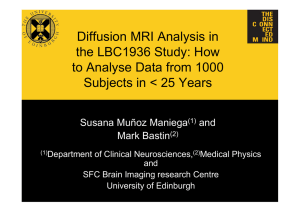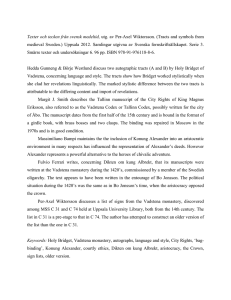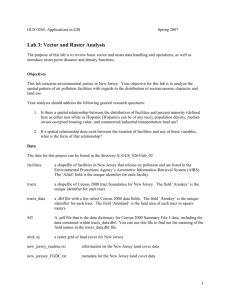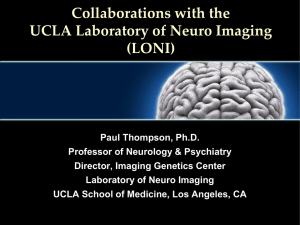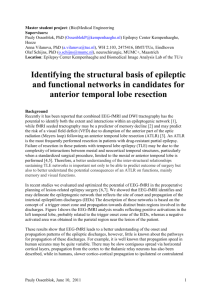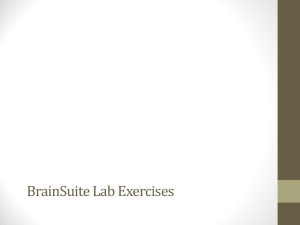Tractography of the anterior thalamic radiation and its relatio
advertisement
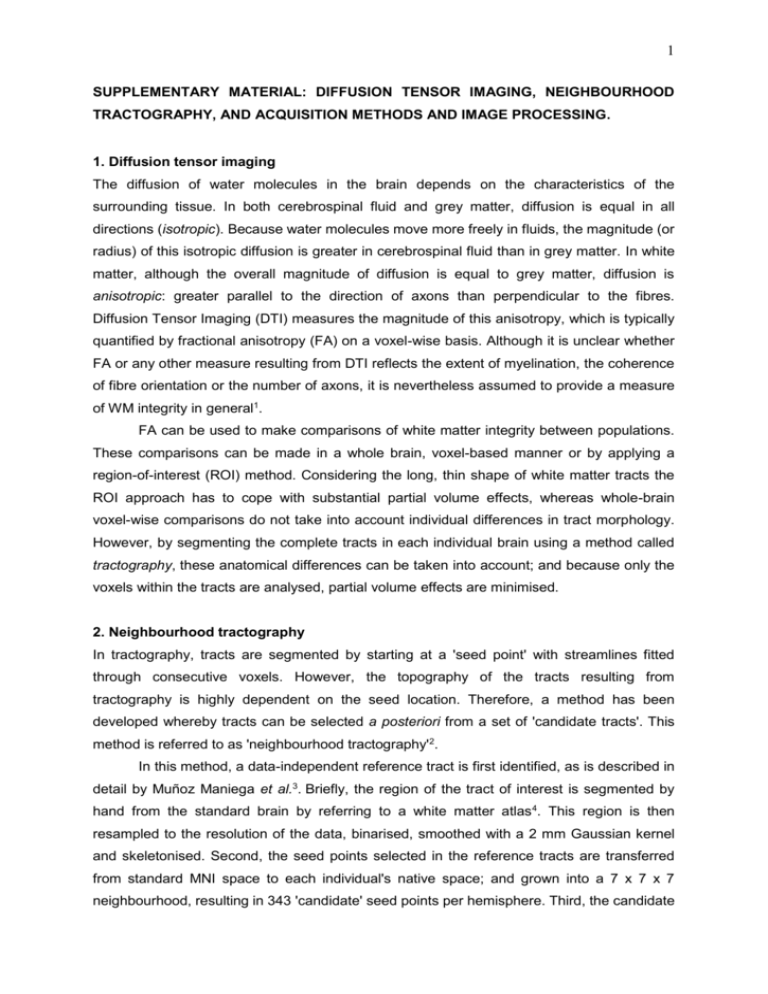
1 SUPPLEMENTARY MATERIAL: DIFFUSION TENSOR IMAGING, NEIGHBOURHOOD TRACTOGRAPHY, AND ACQUISITION METHODS AND IMAGE PROCESSING. 1. Diffusion tensor imaging The diffusion of water molecules in the brain depends on the characteristics of the surrounding tissue. In both cerebrospinal fluid and grey matter, diffusion is equal in all directions (isotropic). Because water molecules move more freely in fluids, the magnitude (or radius) of this isotropic diffusion is greater in cerebrospinal fluid than in grey matter. In white matter, although the overall magnitude of diffusion is equal to grey matter, diffusion is anisotropic: greater parallel to the direction of axons than perpendicular to the fibres. Diffusion Tensor Imaging (DTI) measures the magnitude of this anisotropy, which is typically quantified by fractional anisotropy (FA) on a voxel-wise basis. Although it is unclear whether FA or any other measure resulting from DTI reflects the extent of myelination, the coherence of fibre orientation or the number of axons, it is nevertheless assumed to provide a measure of WM integrity in general1. FA can be used to make comparisons of white matter integrity between populations. These comparisons can be made in a whole brain, voxel-based manner or by applying a region-of-interest (ROI) method. Considering the long, thin shape of white matter tracts the ROI approach has to cope with substantial partial volume effects, whereas whole-brain voxel-wise comparisons do not take into account individual differences in tract morphology. However, by segmenting the complete tracts in each individual brain using a method called tractography, these anatomical differences can be taken into account; and because only the voxels within the tracts are analysed, partial volume effects are minimised. 2. Neighbourhood tractography In tractography, tracts are segmented by starting at a 'seed point' with streamlines fitted through consecutive voxels. However, the topography of the tracts resulting from tractography is highly dependent on the seed location. Therefore, a method has been developed whereby tracts can be selected a posteriori from a set of 'candidate tracts'. This method is referred to as 'neighbourhood tractography'2. In this method, a data-independent reference tract is first identified, as is described in detail by Muñoz Maniega et al.3. Briefly, the region of the tract of interest is segmented by hand from the standard brain by referring to a white matter atlas4. This region is then resampled to the resolution of the data, binarised, smoothed with a 2 mm Gaussian kernel and skeletonised. Second, the seed points selected in the reference tracts are transferred from standard MNI space to each individual's native space; and grown into a 7 x 7 x 7 neighbourhood, resulting in 343 'candidate' seed points per hemisphere. Third, the candidate 2 tracts are generated from the candidate seeds and automatically compared to the reference tract, using an algorithm designed for this purpose2. The candidate tract that best matches the reference tract in terms of length and shape is selected. Finally, the best-match tracts are checked by eye blind to genotype group, and those that are truncated, branched or deviate from the expected anatomical structure are discarded. For the remaining tracts, mean FA values can be calculated which can be compared between samples. 3. Acquisition methods, image processing and ATR segmentation For the present study, MRI data were collected on a GE Signa 1.5 T (General Electric Milwaukee, WI, USA) clinical scanner equipped with a self-shielding gradient set (22mT/m maximum gradient strength) and manufacturer-supplied 'birdcage' quadrature head coil. Whole brain DTI data were acquired for each subject using a single-shot pulsed gradient spin-echo echo-planar imaging (EPI) sequence with diffusion gradients (b = 1000 s/mm²) applied in 51 non-collinear directions, and 3 T2-weighted EPI baseline scans. Forty-eight 2.8 mm contiguous axial slices were acquired with a field-of-view of 220 x 220 mm (TR=17 s, TE=93.4ms and matrix= 96 x 96, zero-filled to 128 x 128). The imaging data were pre-processed using the FSL toolbox (FMRIB, Oxford, UK). The imaging data were corrected for eddy current induced distortions and bulk motion effects by registering all EPI volumes to the first T2-weighted EPI volume. The brain was extracted and FA maps were calculated by fitting the diffusion data to a tensor model with DTIFIT (FMRIB, Oxford, UK). The left and right ATR were identified and segmented in each subject using neighbourhood tractography, as described above. The MNI coordinates of the seed points selected in the reference tract were (-19, 19,-3) mm and (17, 19, 0) mm, for left and right ATR respectively. The candidate tracts were generated using the BEDPOST/ProbTrack algorithm5.The means of the FA values within the selected tracts were weighted according to the likelihood of connection between the voxel and the seed point as given by ProbTrack. Figure 2 depicts two examples of left ATRs resulting from the tractography. 3 References 1. Kubicki, M, McCarley, R, Westin, C, Park, H, Maier, S, Kikinis, R, Jolesz, FA, Shenton, ME. A review of diffusion tensor imaging studies in schizophrenia. J Psychiatr Res 2007; 41:15-30. 2. Clayden, JD, Bastin, ME, Storkey, AJ.Improved segmentation reproducibility in group tractography using a quantitative tract similarity measure. NeuroImage 2006; 33:482-492. 3. Muñoz Maniega S., Bastin M., McIntosh A., Lawrie S. & Clayden J. Atlasbased reference tracts improve automatic white matter segmentation with neighbourhood tractography. In Proceedings of the ISMRM 16th Scientific Meeting & Exhibition. International Society for Magnetic Resonance in Medicine 2008; pp. 3318. 4. Mori, S, Wakana, S, Nagae-Poetscher, L, van Zijl, P. MRI atlas of human white matter. Elsevier: Amsterdam, The Netherlands 2005. 5. Behrens, TEJ, Johansen-Berg, H, Woolrich, MW, Smith, SM, Wheeler-Kingshott, CAM, Boulby, PA, Barker, GJ, Sillery, EL, Sheehan, K, Ciccarelli, O, Thompson, AJ, Brady, JM, Matthews, PM. Non-invasive mapping of connections between human thalamus and cortex using diffusion imaging. Nature Neurosci. 2003; 6:750-757. 4 Figure Legend: Figure 2. Examples of left ATR tracts successfully obtained with tractography in an individual with the CC genotype (left) and a carrier of the T-allele (right) of NRG8SNP243177
